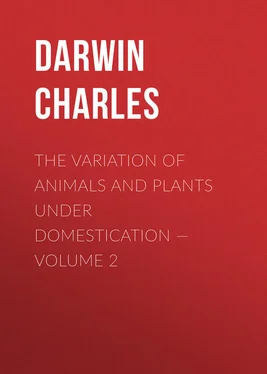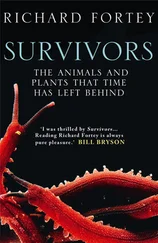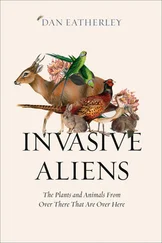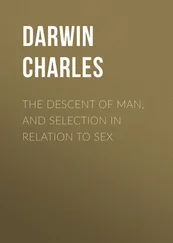Charles Darwin - The Variation of Animals and Plants under Domestication — Volume 2
Здесь есть возможность читать онлайн «Charles Darwin - The Variation of Animals and Plants under Domestication — Volume 2» — ознакомительный отрывок электронной книги совершенно бесплатно, а после прочтения отрывка купить полную версию. В некоторых случаях можно слушать аудио, скачать через торрент в формате fb2 и присутствует краткое содержание. Жанр: foreign_antique, foreign_prose, на английском языке. Описание произведения, (предисловие) а так же отзывы посетителей доступны на портале библиотеки ЛибКат.
- Название:The Variation of Animals and Plants under Domestication — Volume 2
- Автор:
- Жанр:
- Год:неизвестен
- ISBN:нет данных
- Рейтинг книги:3 / 5. Голосов: 1
-
Избранное:Добавить в избранное
- Отзывы:
-
Ваша оценка:
- 60
- 1
- 2
- 3
- 4
- 5
The Variation of Animals and Plants under Domestication — Volume 2: краткое содержание, описание и аннотация
Предлагаем к чтению аннотацию, описание, краткое содержание или предисловие (зависит от того, что написал сам автор книги «The Variation of Animals and Plants under Domestication — Volume 2»). Если вы не нашли необходимую информацию о книге — напишите в комментариях, мы постараемся отыскать её.
The Variation of Animals and Plants under Domestication — Volume 2 — читать онлайн ознакомительный отрывок
Ниже представлен текст книги, разбитый по страницам. Система сохранения места последней прочитанной страницы, позволяет с удобством читать онлайн бесплатно книгу «The Variation of Animals and Plants under Domestication — Volume 2», без необходимости каждый раз заново искать на чём Вы остановились. Поставьте закладку, и сможете в любой момент перейти на страницу, на которой закончили чтение.
Интервал:
Закладка:
The following cases are worth giving, as they relate to monoecious forms, which do not require, and consequently cannot have been injured by, castration. Girou de Buzareingues crossed what he designates three varieties of gourd (16/21. Namely Barbarines, Pastissons, Giraumous: 'Annal. des Sc. Nat.' tome 30 1833 pages 398 and 405.), and asserts that their mutual fertilisation is less easy in proportion to the difference which they present. I am aware how imperfectly the forms in this group were until recently known; but Sageret (16/22. 'Memoire sur les Cucurbitaceae' 1826 pages 46, 55.), who ranked them according to their mutual fertility, considers the three forms above alluded to as varieties, as does a far higher authority, namely, M. Naudin. (16/23. 'Annales des Sc. Nat.' 4th series tome 6. M. Naudin considers these forms as undoubtedly varieties of Cucurbita pepo.) Sageret (16/24. 'Mem. Cucurb.' page 8.) has observed that certain melons have a greater tendency, whatever the cause may be, to keep true than others; and M. Naudin, who has had such immense experience in this group, informs me that he believes that certain varieties intercross more readily than others of the same species; but he has not proved the truth of this conclusion; the frequent abortion of the pollen near Paris being one great difficulty. Nevertheless, he has grown close together, during seven years, certain forms of Citrullus, which, as they could be artificially crossed with perfect facility and produced fertile offspring, are ranked as varieties; but these forms when not artificially crossed kept true. Many other varieties, on the other hand, in the same group cross with such facility, as M. Naudin repeatedly insists, that without being grown far apart they cannot be kept in the least true.
Another case, though somewhat different, may be here given, as it is highly remarkable, and is established on excellent evidence. Kolreuter minutely describes five varieties of the common tobacco (16/25. 'Zweite Forts.' s. 53 namely Nicotiana major vulgaris; (2) perennis; (3) transylvanica; (4) a sub- var. of the last; (5) major latifol. fl. alb.) which were reciprocally crossed, and the offspring were intermediate in character and as fertile as their parents: from this fact Kolreuter inferred that they are really varieties; and no one, as far as I can discover, seems to have doubted that such is the case. He also crossed reciprocally these five varieties with N. glutinosa, and they yielded very sterile hybrids; but those raised from the var. perennis, whether used as the father or mother plant, were not so sterile as the hybrids from the four other varieties. (16/26. Kolreuter was so much struck with this fact that he suspected that a little pollen of N. glutinosa in one of his experiments might have accidentally got mingled with that of var. perennis, and thus aided its fertilising power. But we now know conclusively from Gartner ('Bastarderz.' s. 34, 43) that the pollen of two species never acts CONJOINTLY on a third species; still less will the pollen of a distinct species, mingled with a plant's own pollen, if the latter be present in sufficient quantity, have any effect. The sole effect of mingling two kinds of pollen is to produce in the same capsule seeds which yield plants, some taking after the one and some after the other parent.) So that the sexual capacity of this one variety has certainly been in some degree modified, so as to approach in nature that of N. glutinosa. (16/27. Mr. Scott has made some observations on the absolute sterility of a purple and white primrose (Primula vulgaris) when fertilised by pollen from the common primrose ('Journal of Proc. of Linn. Soc.' volume 8 1864 page 98); but these observations require confirmation. I raised a number of purple-flowered long- styled seedlings from seed kindly sent me by Mr. Scott, and, though they were all in some degree sterile, they were much more fertile with pollen taken from the common primrose than with their own pollen. Mr. Scott has likewise described a red equal-styled cowslip (P. veris ibid page 106), which was found by him to be highly sterile when crossed with the common cowslip; but this was not the case with several equal-styled red seedlings raised by me from his plant. This variety of the cowslip presents the remarkable peculiarity of combining male organs in every respect like those of the short-styled form, with female organs resembling in function and partly in structure those of the long-styled form; so that we have the singular anomaly of the two forms combined in the same flower. Hence it is not surprising that these flowers should be spontaneously self-fertile in a high degree.)
These facts with respect to plants show that in some few cases certain varieties have had their sexual powers so far modified, that they cross together less readily and yield less seed than other varieties of the same species. We shall presently see that the sexual functions of most animals and plants are eminently liable to be affected by the conditions of life to which they are exposed; and hereafter we shall briefly discuss the conjoint bearing of this fact, and others, on the difference in fertility between crossed varieties and crossed species.
DOMESTICATION ELIMINATES THE TENDENCY TO STERILITY WHICH IS GENERAL WITH SPECIES WHEN CROSSED.
This hypothesis was first propounded by Pallas (16/28. 'Act. Acad. St. Petersburg' 1780 part 2 pages 84, 100.), and has been adopted by several authors. I can find hardly any direct facts in its support; but unfortunately no one has compared, in the case of either animals or plants, the fertility of anciently domesticated varieties, when crossed with a distinct species, with that of the wild parent-species when similarly crossed. No one has compared, for instance, the fertility of Gallus bankiva and of the domesticated fowl, when crossed with a distinct species of Gallus or Phasianus; and the experiment would in all cases be surrounded by many difficulties. Dureau de la Malle, who has so closely studied classical literature, states (16/29. 'Annales des Sc. Nat.' tome 21 1st series page 61.) that in the time of the Romans the common mule was produced with more difficulty than at the present day; but whether this statement may be trusted I know not. A much more important, though somewhat different, case is given by M. Groenland (16/30. 'Bull. Bot. Soc. de France' December 27, 1861 tome 8 page 612.), namely, that plants, known from their intermediate character and sterility to be hybrids between Aegilops and wheat, have perpetuated themselves under culture since 1857, WITH A RAPID BUT VARYING INCREASE OF FERTILITY IN EACH GENERATION. In the fourth generation the plants, still retaining their intermediate character, had become as fertile as common cultivated wheat.
The indirect evidence in favour of the Pallasian doctrine appears to me to be extremely strong. In the earlier chapters I have shown that our various breeds of the dog are descended from several wild species; and this probably is the case with sheep. There can be no doubt that the Zebu or humped Indian ox belongs to a distinct species from European cattle: the latter, moreover, are descended from two forms, which may be called either species or races. We have good evidence that our domesticated pigs belong to at least two specific types, S. scrofa and indicus. Now a widely extended analogy leads to the belief that if these several allied species, when first reclaimed, had been crossed, they would have exhibited, both in their first unions and in their hybrid offspring, some degree of sterility. Nevertheless, the several domesticated races descended from them are now all, as far as can be ascertained, perfectly fertile together. If this reasoning be trustworthy, and it is apparently sound, we must admit the Pallasian doctrine that long- continued domestication tends to eliminate that sterility which is natural to species when crossed in their aboriginal state.
Читать дальшеИнтервал:
Закладка:
Похожие книги на «The Variation of Animals and Plants under Domestication — Volume 2»
Представляем Вашему вниманию похожие книги на «The Variation of Animals and Plants under Domestication — Volume 2» списком для выбора. Мы отобрали схожую по названию и смыслу литературу в надежде предоставить читателям больше вариантов отыскать новые, интересные, ещё непрочитанные произведения.
Обсуждение, отзывы о книге «The Variation of Animals and Plants under Domestication — Volume 2» и просто собственные мнения читателей. Оставьте ваши комментарии, напишите, что Вы думаете о произведении, его смысле или главных героях. Укажите что конкретно понравилось, а что нет, и почему Вы так считаете.












